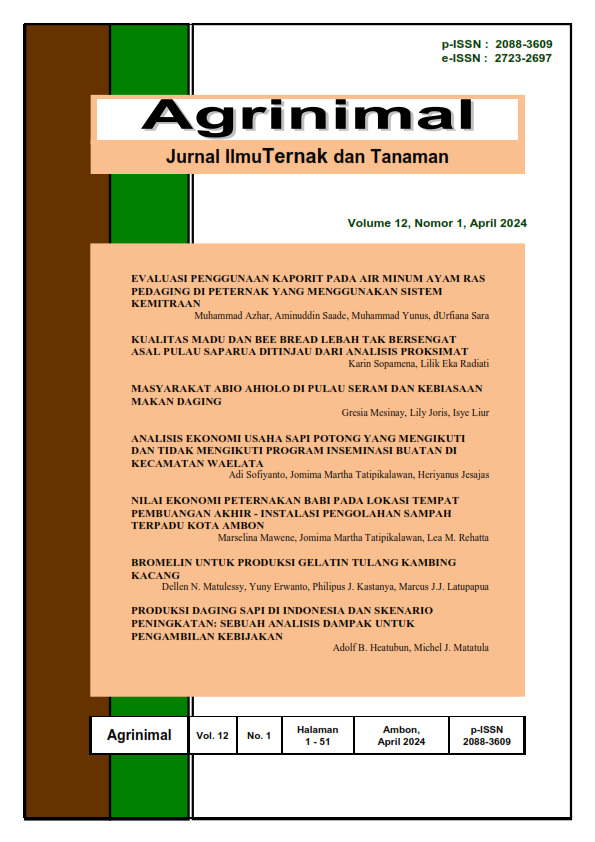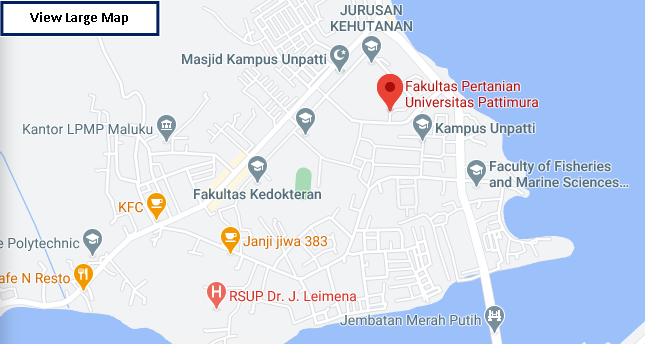ANALISIS EKONOMI USAHA SAPI POTONG YANG MENGIKUTI DAN TIDAK MENGIKUTI PROGRAM INSEMINASI BUATAN DI KECAMATAN WAELATA
ECONOMIC ANALYSIS OF BEEF CATTLE FARMS THAT PARTICIPATED IN THE ARTIFICIAL INSEMINATION PROGRAM AND DID NOT PARTICIPATE IN WAELATA DISTRICT
Abstract
Rendahnya adopsi teknologi inseminasi buatan (IB) disebabkan peternak masih ragu dengan nilai ekonomi yang didapat dari mengikuti program tersebut. Tujuan penelitian ini adalah mengetahui besar biaya produksi dan pendapatan peternak sapi potong, kontribusi ternak sapi potong terhadap total pendapatan dan perbedaan pendapatan dan kontribusi pendapatan peternak sapi potong yang mengikuti dan yang tidak mengikuti program inseminasi buatan (IB). Penelitian dilaksanakan di Kecamatan Waelata yang merupakan salah satu wilayah pengembangan sapi potong di Kabupaten Buru. Sampel wilayah sebanyak 3 desa diambil secara purposive sampling dan sampel responden sebanyak 85 peternak yang terdiri dari 30 responden mengikuti program Inseminasi buatan (IB) dan 55 responden yang tidak mengikuti. Pengambilan data menggunakan metode focus discussion group (FGD), survey, dan observasi. Analisis data secara deskriptif, perhitungan ekonomi, kontribusi pendapatan dan analisis uji beda untuk mengetahui perbedaan pendapatan. Hasil penelitian menunjukkan bahwa besar biaya produksi usaha ternak sapi potong yang mengikuti program IB sebesar Rp 5.490.444,- dengan pendapatan Rp. 14.207.022,66 per tahun dan besar biaya produksi yang tidak mengikuti program IB Rp. 2.188.925,91 dengan pendapatan Rp, 7.085.185,01 per tahun. Kontribusi pendapatan dari usaha sapi potong hasil IB 46,89% lebih besar dari yang tidak mengkuti program IB 32,69% dan merupakan cabang usaha. Terdapat perbedaan pendapatan antara usaha sapi potong yang mengikuti dengan yang tidak mengikuti program IB.
ABSTRACT
The low adoption of artificial insemination (AI) technology is because breeders are still unsure about the economic value gained from participating in the program. The aim of this research is to determine the production costs and income of beef cattle breeders, the contribution of beef cattle to total income and the difference in income and income contribution of beef cattle breeders who participate and who do not participate in the artificial insemination (AI) program. The research was carried out in Waelata District, which is one of the beef cattle development areas in Buru Regency. A regional sample of 3 villages was taken using purposive sampling and the sample of respondents was 85 breeders consisting of 30 respondents who participated in the Artificial Insemination (AI) program and 55 respondents who did not. Data collection used focus group discussion (FGD), survey and observation methods. Descriptive data analysis, economic calculations, income contribution and analysis of difference tests to determine income differences. The results of the research show that the production costs for beef cattle businesses that take part in the AI program are IDR 5,490,444,- with an income of IDR. 14,207,022.66 per year and the production costs that do not participate in the IB program are Rp. 2,188,925.91 with an income of Rp. 7,085,185.01 per year. The income contribution from beef cattle businesses resulting from IB is 46.89% greater than those that do not participate in the IB program 32.69% and are business branches. There is a difference in income between beef cattle businesses that participate and those that do not participate in the AI program.
Downloads
References
Abraha, B., M. Gezahegn., & Yousuf, J. (2020). Adoption of Artificial Insemination Service for Cattle Crossbreeding by Smallholder Farmers in Laelay-Maichew District, Tigray, Ethiopia. Journal of Development and Agricultural Economics, 12(2), 104-112.
Andang, A. A., Asri & Sumaryanto. (2021). Hubungan Karakteristik Peternak Terhadap Respons Pembuatan Briket BioArang Berbahan Dasar Kotoran Kambing dan Serbuk Gergaji di Desa Tampingan Kecamatan Tegalrejo. Jurnal Penelitian Peternakan Terpadu, 3 (5), 110 – 121.
Asmairiencen S. Y. Yusriani ., & Hayati S.Y., (2017) Potential Development of Artificial Insemination (IB) to Increase the Population in Support of the SIWAB Program in Gayo Lues District of Aceh Province. Proceedings of Semnas VI HIPTI. ISBN 978-60250946-0-6.
Bachev, H., Ivanov, B., Toteva, D., & Sokolova, E. (2017). Agrarian Sustainability in Bulgaria – Economic, Social and Ecological Aspects. Bulgarian Journal of Agricultural Science, 23(4), 519-525.
[BPS] Badan Pusat Statistik Kabupaten Buru. (2022). Kabupaten Buru dalam Angka. Namlea: Badan Pusat Statistik Kabupaten Buru.
Dehinenet, G., Mekonnen, H., Kidoido, M., Ashenafi, M., & Guerne Bleich, E. (2014). The Impact of Dairy Technology Adoption on Smallholder Dairy Farmer’s Livelihoods in Selected Zones of Amhara and Oromia National Regional States, Ethiopia. Global Science Research Journals, 2(1), 104–113.
Fania, B., Trilaksana, I. G. N. B., & Puja, I. K. (2020). Keberhasilan inseminasi buatan (IB) pada sapi bali di Kecamatan Mengwi, Badung, Bali. Indonesia Medicus Veterinus, 9(2), 177-186.
Hakim, M. H., Siregar, A. R., & Hamid, N. (2023). Agribisnis Sapi Potong Melalui Tindakan Inseminasi Buatan di Kecamatan Sinjai Tengah Kabupaten Sinjai Mahatani. Agribusiness and Agricultural Economics Journal, 6(1), 1-12.
Hartono, B., & Rohaeni, E. S. (2014). Contribution to Income of Traditional Beef Cattle Farmer Households in Tanah Laut Regency, South Kalimantan, Indonesia. Livestock Research for Rural Development, 26(8), 10-18.
Hidayah, N., Artdita, C. A., & Lestari, F. B. (2019). Pengaruh Karakteristik Peternak Terhadap Adopsi Teknologi Pemeliharaan pada Peternak Kambing Peranakan Ettawa di Desa Hargotirto Kabupaten Kulon Progo. Jurnal Bisnis & Manajemen, 19(1):1-10.
Holm, D. E., Thompson, P. N., & Irons, P. C. (2008). The Economic Effects of an Estrus Synchronization Protocol Using Prostaglandin in Beef Heifers. Theriogenology, 70(9), 1507-1515.
Indey, S., Saragih, E. W., & Santoso, B. (2022). Karakteristik Peternak Sapi di Sentra Produksi Ternak Potong di Kabupaten Sorong. Jurnal Ilmu Peternakan Dan Veteriner Tropis, 11(3), 245-256.
Kusrianty, N., Awalludin, & Mirajuddin. (2016). Efektifitas Inseminasi Buatan Pada Sapi Potong Menggunakan Semen Cair. E-Jurnal Mitra Sains, 4(1):50-57.
Lamb, G. C., & Mercadante, V. R. (2016). Synchronization and Artificial Insemination Strategies in Beef Cattle. Veterinary Clinics: Food Animal Practice, 32(2), 335-347.
Li, M., & Sicular, T. (2013). Aging of the Labor Force and Technical Efficiencyin Crop Production: Evidence from Liaoning Province, China. China Agricultural Economic Review, 5(3), 342-359.
Nurdiyansah, I., Suherman, D., & Putranto, H. D. (2020). Hubungan Karakteristik Peternak dengan Skala Kepemilikan Sapi Perah di Kecamatan Kabawetan Kabupaten Kepahiang. Buletin Peternakan Tropis, 1(2), 64-72.
Prayitno, R.S. (2018). Analisis Usaha Ternak Indukan Sapi Peranakan Simental Di Kecamatan Patean Kabupaten Kendal. Agromedia, 36(1), 97-105.
Polakitan, D., Silondae, H., & Ifada, R. R. (2021). Efforts to Increase Beef Cattle Population with Artificial Insemination Application in North Sulawesi, Indonesia. In E3S Web of Conferences, Vol. 306, p. 03015.
Rana, H. A. A., Iftikhar, M., Watto, M. A., & Bilal, M. Q. (2021). Farmers’ Perceptions Regarding Artificial Insemination Services in Punjab, Pakistan. International Journal of Agricultural Extension, 9(2), 163-170.
Rodgers J.C., Bird S L., Larson, J. E., DiLorenzo, N., Dahlen, C. R., DiCostanzo, A., and Lamb, G.C. (2012). An Economic Evaluation of Estrus Synchronization and Timed Artificial Insemination in Suckled Beef Cows. J. Anim. Sci, 90 (11), 4055-4062.
Sastrawan, S., Futra,S., Nikmah, A., Novoandi, I., & Syahputra I. (2022). Hubungan Karakteristik Peternak Terhadap Penambahan Populasi Ternak Kambing di Kecamatan Jagong Jeget Kabupaten Aceh Tengah. Jurnal Ilmu Ternak dan Veteriner, 4 (2): 1-7.
Simamora, T., & Matoneng, O.W. (2024). Karakteristik Peternak, Sifat dan Proses Adopsi Inovasi Peternakan Sapi Potong di Kabupaten Timor Tengah Utara (TTU). Jurnal of Animal Science, 9(1), 9-11.
Sugiarto, M., Wakhidati, Y. N., Einstein, A., & Saleh, D. M. (2019). The Influence of Artificial Insemination (AI) Cost To Profitability of Beef Cattle Farming in Banjarnegara District, Central Java Province, Indonesia. In IOP Conference Series: Earth and Environmental Science, 247(1), p. 012046).
Titirloloby, Y. (2023). Analisis Perilaku Peternak dalam Meningkatkan Pendapatan Usaha Sapi Potong Rakyat di Kecamatan Waeapo Kabupaten Buru Utara. Jurnal Peternakan Sabana, 2(3), 132-139.
Welerubun, I. N., Titik, E., & Agus, S. (2016). Faktor-Faktor yang Mempengaruhi Pendapatan Peternak Domba Kisar Di Pulau Kisar Kabupaten Maluku Barat Daya. Agromedia, 34 (2), 54-64.
Zuidema, D., Kerns, K., & Sutovsky, P. (2021). An Exploration of Current and Perspective Semen Analysis and Sperm Selection for Livestock Artificial Insemination. Animals, 11(12), 3563.








